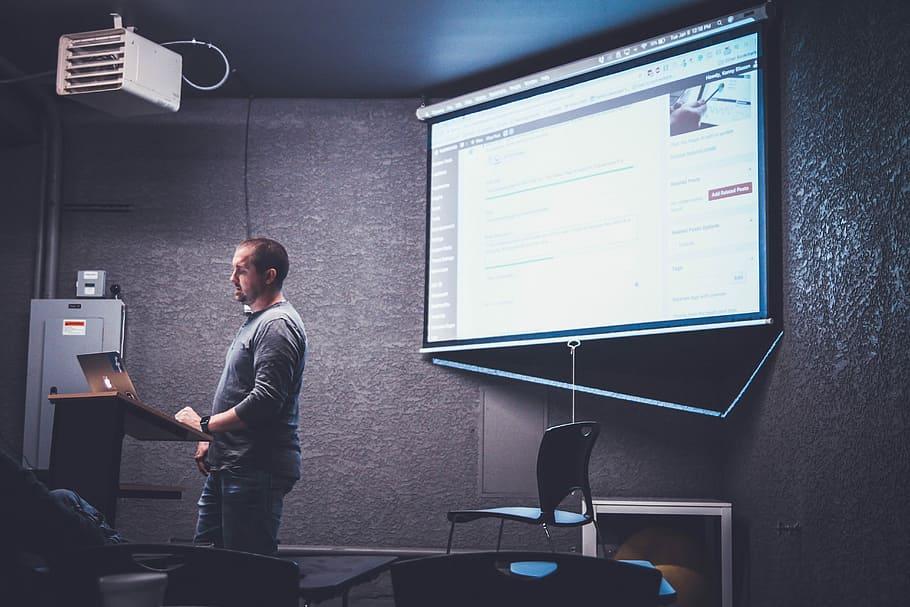Are you passionate about teaching and technology? If yes, then becoming a computer teacher might be your perfect career path. I’m a computer teacher, and I know how rewarding it is.
Today, I will take you through a day in the life of a computer teacher. Let’s dive in! By the end, you can decide if this career path suits you.
Who Is A Computer Teacher?
Computer teachers teach students computer-related knowledge and skills. They may prioritize topics for certain computer use.
There are various types of computer teachers. Depending on the specific career path, the teachers have different opportunities. And, of course, each position requires a specific degree, license, and field of study.
For example, elementary and high school computer teachers need a bachelor’s degree. They also have to prepare a license to work in public schools. Aside from technology, these teachers focus on elementary/secondary education.
On the other hand, a postsecondary computer teacher must have a master’s degree. They teach computer analysis, computer programming, and database management.

I’m teaching at a high school. My timetable looks the same, but every day brings new challenges. That’s how I continue to learn and grow as an educator.
1. Morning Preparation
Each morning, I start my day by preparing for the classes ahead. I carefully plan lessons and activities to help my students acquire computer skills.
I’m in charge of various classes at a time. Thus, to help my students, I have to choose topics and materials depending on their levels.
2. Morning Classes
When the morning classes start, I step into the classroom with enthusiasm. My goal is to deliver my lessons in a way that boosts my students’ confidence in their abilities.
To achieve that goal, I break down complex concepts into simple terms. I also use examples that resonate with my students.
Additionally, I pay close attention to the dynamics in the classroom. I want everyone to feel comfortable, so I try to involve my students in all activities.
Building interactions with my students is crucial. I want to know them personally. Only after I understand their difficulties can I offer appropriate support plans.
Students have their own challenges. If they ask me for help, then I will be there to support and guide them.
During the classes, I play the role of an invigilator. So I give our quizzes, projects, and exams to assess my students’ progress. After that, I grade their assignments.
I also pay a lot of attention to this examination part. It’s an excellent method to help me maintain class order. Then, based on that, I can create a healthy learning environment where students interact with each other positively.
3. Afternoon Classes
I have a short break after taking morning classes. It’s time for lunch and a quick nap, so I never skip it. I need to recharge my battery for the afternoon classes.
In the afternoon, I teach other classes. The lesson plans are different, but I use the same energy for them.
4. Meetings
These meetings occur at various intervals throughout the academic year. And aside from the monthly meetings, we gather at the beginning and end of every semester.
During the monthly meetings, I actively discuss with other teachers and administrators. It’s an opportunity for us to share updates and address any concerns.
Regular meetings like these help ensure that everyone is on the same page. Then, we can work towards common goals.
On the other hand, at the start of the semester, we have meetings to set expectations and review curriculum changes.
Toward the end of the semester, my school holds meetings, too. It’s a valuable time for reviewing student achievements. During the discussion, we also plan for the upcoming semester.
5. After Work
After work, I focus on my own professional growth. So, I dedicate time to upgrading my skills. There are various ways to do it. For example, I like to attend webinars and take online courses. I’m a teacher, but I love studying, too.
By staying curious, I can inspire my students. I hope that they can be lifelong learners themselves.
Relaxation and self-care are important, too. I can take a stroll outside during breaks or after work to enjoy some fresh air. It’s a simple way to clear my mind and rejuvenate.
I spend time on my hobby as well. Jogging is effective in boosting my energy levels. I also like to get lost in a good book about my major.

Essential Skills
I spend a lot of time upgrading my level. But what skills do I work on?
Hard skills
I have learned how to write code using programming languages. This knowledge allows me to create exciting programming lessons for my students.
I also need to understand the rules and concepts of web design. Then, I use it to teach my students how to design their very own web pages.
Computer networks are important, too. My engineering background allows me to guide students in thrilling projects.
Soft skills
Communication skills are crucial for teachers. I use effective communication to help students thoroughly understand complex concepts.
Additionally, critical thinking plays a vital role in solving technology-related problems. It helps me find creative solutions.

Is Becoming A Computer Teacher Worth It?
Yes. From my own experience, I can tell you that it brings immense satisfaction.
First, I earn the respect of my students and colleagues. Seeing my students’ excitement when they learn new computer skills is truly inspiring.
Furthermore, this job offers good career prospects. The high salary is also a big motivation.

Conclusion
Being a computer teacher is not just a job because it’s a passion. I want to make a positive impact on my students’ lives.
Hopefully, my story can inspire you to become an educator. Trust me; witnessing your students’ growth is among the most rewarding things ever.
Thank you for reading!
